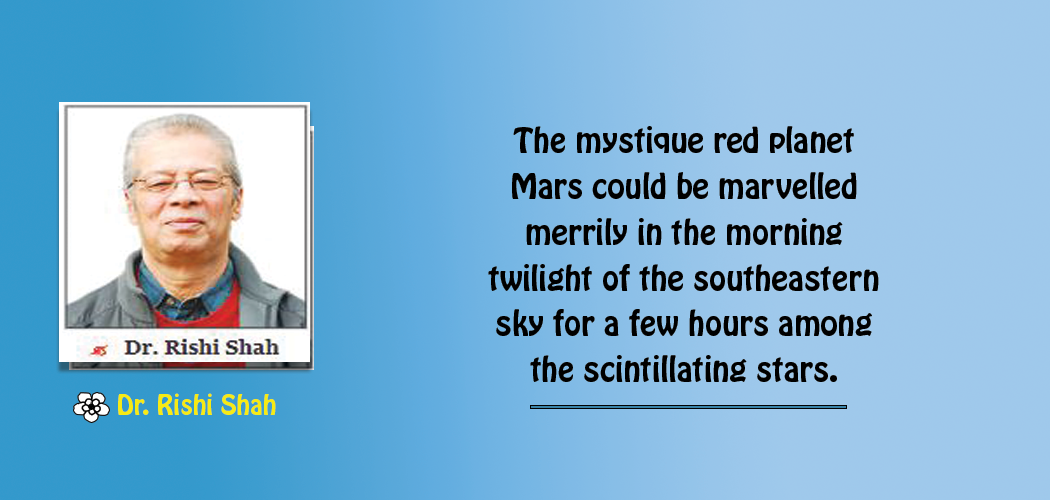- Wednesday, 24 December 2025
NIGHT SKY IN MAY 2022 Pre-dawn Rendezvous Of Major Planets
Dr. Rishi Shah
This month's night skies exhibit the exquisite elegance of major planets during their pre-dawn rendezvous in the eastern sky. The elusive planet Mercury and the far-flung planet Uranus will stay out of sight for most of the month. They would be scurrying near the sun and cavorting with the stars of Taurus (bull) and Aries (ram). Venus and Jupiter could be viewed at dawn in the eastern sky among the stars of Pisces (fishes) until sunup. The blue planet Neptune could be perceived very succinctly in the eastern sky after the middle of the month, as it would be mingling with the stars of Pisces.
The cute circlet asterism of Pisces would be hovering above them. The mystique red planet Mars could be marvelled merrily in the morning twilight of the southeastern sky for a few hours among the scintillating stars that couture the comely constellations Aquarius (water bearer) and Pisces. Planet Saturn could be savoured splendidly in the eastern sky after midnight until early in the morning before sunrise. The stars would be spotted with the stars that sketch the eastern section of the triangle-shaped constellation Capricornus (sea goat).
Stunning show
The pleasing planets Jupiter, Neptune, Venus and Mars will be performing a stunning show in the south-eastern sky before the day begins. They would come very close to each other for terrific trysts. Planet Venus will meet Jupiter on 01 May. Mars and Neptune will embrace each other on 18 May and likewise, Jupiter will approach Mars on 29 May. Amazing asteroid 10 Hygiea could be chased comfortably from dusk into the south-eastern sky until after midnight above the south-western horizon.
The average Eta Aquarid meteor shower would be displaying up to 60 shiny meteors per hour at its peak this year from the late night of 06 May till the morning of the 07 May 2022. The meteors have been allegedly produced by dust particles left behind by the iconic comet 1P/Halley, which has been observed since 250 BC. Its orbital period would be whooping 76 years. The meteor shower would be evident from 19 April to 28 May
The emanating point of meteors would arise in the wee hours after midnight and be climbing toward its highest location at daybreak. Earth will plough through the comet's path twice annually, currently causing Eta Aquariids and in late October when offering Orionid meteor showers. Eta Aquarii would be truly 170 light-years away, while the Eta Aquariids would burn up barely one-hundred kilometres above the earth. Eta Aquarii would indicate three times the solar mass and purely three times the Sun's radius.
The star has been exuding 103 times the Sun's luminosity at a scorching temperature of 0769 degrees Celsius. Halley's Comet had returned last in 1985/86. Presently, the comet will be swooping supposedly beyond the trajectory of Neptune through the longest constellation Hydra (sea serpent) towards the peculiar binary star Procyon (Manda) residing in the charming constellation Canis Minor (lesser dog). Procyon would be scant 11.6 light-years away from us. In December 2023, the comet would arrive at its farthest place (aphelion) from the Sun at ostensibly 35.082 AU. One Astronomical Unit (AU) would define the mean distance between Sun and earth. It would measure approximately 150 million kilometres.
A total lunar eclipse will occur on 16 May. The eclipse could be followed from North America, Greenland, the Atlantic Ocean and parts of Western Europe, western Africa and French Polynesia. It cannot be evinced from Kathmandu since the moon would be beneath the horizon at the time of the eclipse. Unlike solar eclipses, lunar eclipses are entirely safe to look at without using any kind of filter. During this type of eclipse, the earth would glide between the moon and Sun and obscure the Sun's light to cast a shadow on the moon's surface.
Temperature variations may have been related to seasonal modifications in Neptune's atmospheric chemistry, which could alter as the atmosphere freezes. Random variability in weather patterns or even response to the 11-year solar activity cycle may have an effect. The recently launched James Webb Space Telescope could decode quirky conundrums of the chemistry and temperatures in Neptune's atmosphere and help to better identify the nature of these latest changes. Now fully focused on its assigned mission, Webb would continuously comprehend the distant stars.
Neptune
The planet Neptune would be circa 4.5 billion kilometres from earth. Neptune would require around 165 earth years to lumber around the Sun. Its seasons would dramatically dawdle on for merely forty years. Unlike our home planet, which would heat in summertime, the azure world of Neptune's south side, which would be in the midst of summer, was seemingly cooling down. Neptune is our eighth wonder planet, meagrely four times wider than earth. Neptune would need fairly sixteen hours to rotate once (Neptunian day), and about 165 earth years to orbit the sun (Neptunian year).
Neptune is an ice giant with water, methane and ammonia above a queer rocky core. Neptune's atmosphere is composed mostly of molecular hydrogen, atomic helium and methane. Neptune has fourteen known moons named after sea gods and nymphs in Greek legends. Neptune possesses five main rings and four ring arcs. Voyager-2 was the sole spacecraft to have visited Neptune to study it at length. Neptune cannot support life as we know it. Because of the dwarf planet Pluto's elliptical track, it would sometimes venture remarkably closer to the Sun (and us) than Neptune.
(Dr. Shah, an academician at NAST, is patron of the Nepal Astronomical Society (NASO).

















